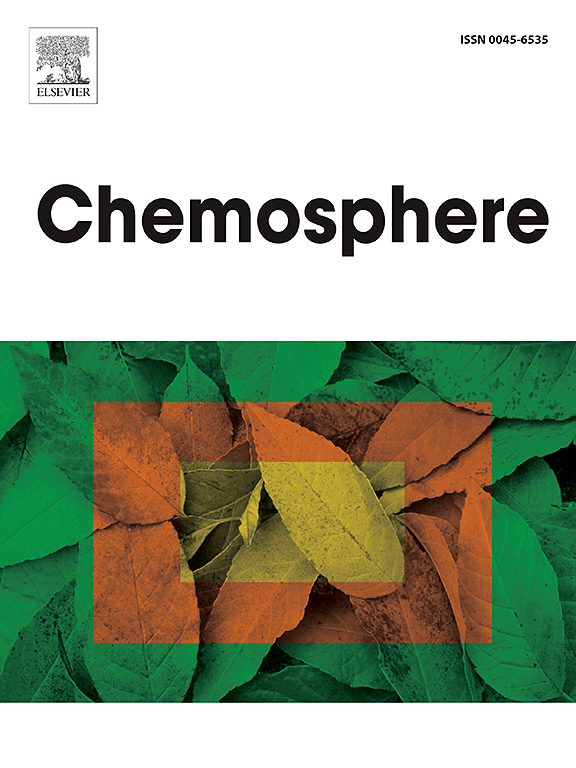活性炭吸附二恶英的加速溶剂萃取:响应面法优化
IF 8.1
2区 环境科学与生态学
Q1 ENVIRONMENTAL SCIENCES
引用次数: 0
摘要
活性炭(AC)是一种有效的吸附类二恶英化合物,从而降低其生物利用度。因此,交流电修复是修复二恶英污染土壤的一种很有前途的工具,但跟踪修复结果需要量化在交流电中隔离的二恶英。定量土壤中二恶英的标准方法往往无法从AC中提取二恶英,因此本研究通过优化加速溶剂萃取(ASE)方法来解决这一空白。基于AC孔体积的初始湿法可有效制备可重复、均匀且强的二恶英-AC配合物,并可通过14C-2378-TCDD进行验证。用交流隔离的2378-TCDD进行了初步提取,确定了交流表面积、萃取温度和溶剂体系组成是关键的自变量。根据Box-Behnken响应面法进行ASE提取试验,并对结果数据进行统计分析,以了解这些变量与模型提取效率的相互作用。该模型使用AC中的2378-TCDD推导,也有效地预测了从三种比表面积为100至1100 m2/g的AC材料中提取所有17种毒性最强的二恶英/呋喃同系物的效率。优化后的提取方法对二恶英同系物的平均提取效率为70-90%,这取决于活性炭的表面积。本研究改进了碳质材料中二恶英的定量,表明提取温度高于200°C才能提高效率,为更可靠地评估和修复二恶英类化合物铺平了道路。本文章由计算机程序翻译,如有差异,请以英文原文为准。

Accelerated solvent extraction of dioxins sequestered in activated carbon: A response surface methodology-based optimization
Activated carbon (AC) is an effective sorbent for sequestering dioxin-like compounds, thereby reducing their bioavailability. Consequently, AC amendment is a promising tool for remediating dioxin-polluted soils, but tracking remediation results requires quantification of the dioxins sequestered within ACs. Standard methods for quantifying dioxins in soils are often unable to extract dioxins from AC, so the present study addresses this gap by optimizing an accelerated solvent extraction (ASE) method. The incipient wetness method, based on AC pore volume, was found effective for preparing reproducible, homogeneous, and strong dioxin-AC complexes to test extraction processes, and was validated using 14C-2378-TCDD. Preliminary extractions were conducted with AC-sequestered 2378-TCDD, and identified AC surface area, extraction temperature, and solvent system composition as key independent variables. Extraction trials using ASE were performed according to the Box-Behnken response surface methodology, and the resulting data were statistically analyzed to understand the interaction of these variables and model extraction efficiency. This model, derived using 2378-TCDD in AC, was also effective for predicting the extraction efficiencies for all 17 of the most toxic dioxin/furan congeners from three AC materials with specific surface areas from 100 to 1100 m2/g. The optimized extraction methodology achieved an average extraction efficiency of 70–90% for dioxin congeners, depending on the surface area of the AC. This study improves the quantification of dioxins in carbonaceous materials, shows that extraction temperatures above 200 °C are required for higher efficiencies, and paves the way for more reliable assessment and remediation of dioxin-like compounds.
求助全文
通过发布文献求助,成功后即可免费获取论文全文。
去求助
来源期刊

Chemosphere
环境科学-环境科学
CiteScore
15.80
自引率
8.00%
发文量
4975
审稿时长
3.4 months
期刊介绍:
Chemosphere, being an international multidisciplinary journal, is dedicated to publishing original communications and review articles on chemicals in the environment. The scope covers a wide range of topics, including the identification, quantification, behavior, fate, toxicology, treatment, and remediation of chemicals in the bio-, hydro-, litho-, and atmosphere, ensuring the broad dissemination of research in this field.
 求助内容:
求助内容: 应助结果提醒方式:
应助结果提醒方式:


